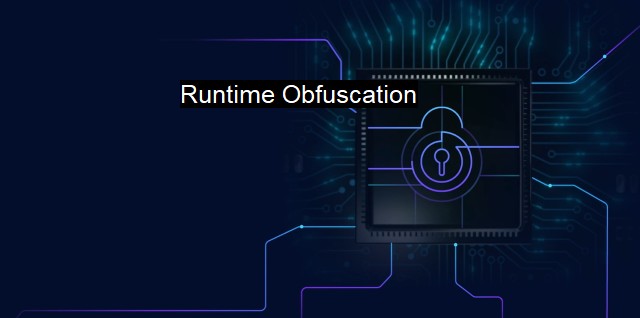What is Runtime Obfuscation?
Cybersecurity 101: The Power of Runtime Obfuscation in Protecting Software Code from Reverse Engineering and Malicious Actors
Runtime obfuscation is a unique cybersecurity technique that transforms standard binary into different and complex code structures during execution time, making it challenging to analyze or reverse-engineer. £his is not to be confused with traditional static obfuscation, which transforms code prior to execution, hence being detectable and decipherable with sophisticated tools. In the case of runtime code obfuscation, code is altered during execution, providing an essentially different level of protection.The primary objective of runtime obfuscation is to make software code more difficult for humans and mechanisms such as bots and malware to understand without affecting application performance and functionality. Ideally, an obfuscator should make a program so complex to decipher that no individual or automated tool can make enough sense of it to perform malicious activities.
To put it simply, runtime obfuscators convolute the "readability" of a system's code during execution, obfuscating the program's true intentions and confounding enemies. Consequently, those attempting to maliciously manipulate or understand the systems are significantly held at bay since the processes supporting the analysis of the code are disrupted. Therefore, in the context of cyber security, runtime obfuscation becomes an imperative protection mechanism.
To accomplish runtime obfuscation, a number of methods can be used. These typically involve techniques such as decrypting the software code just-in-time for execution, relocating execution pointers to different areas within the code, or introducing redundant code that does not pertain to the task at hand but exists solely to confuse cybercriminals and automated reversing tools. By implementing these techniques, cyber security professionals are equipped to deflect attacks and safeguard critical systems against vulnerabilities.
The complexity that runtime obfuscation provides also serves as an effective deterrent. It creates an additional layer of defense by increasing the amount of cognitive work and time an attacker must invest to understand, manipulate, and exploit the application. This often results in thwarting the functions of automated attacking tools, as they follow a predictable logic and can be led astray by the elegant misdirections created by the obfuscation.
In addition to defense, runtime obfuscation offers a crucial element of proactive offense to cyber-security strategies. Since obfuscated code is difficult to interpret, it forces attackers to consume more time and computational resources to decipher its structures and designs. The longer it takes them, the better is the opportunity for security professionals to track, pinpoint, and neutralize potential threats.
Although having substantial pros, runtime obfuscation too has its fair share of cautions to heed. Malicious entities can deploy obfuscation as well to hide their harmful intentions creating ambiguity for antivirus programs. This could lead to advanced persistent threats that are hard to identify until significant damage has been triggered. Consequently, antivirus software developers are engaged continuously in improving their detection strategies against such obfuscated threats – this establishes a constant cat-and-mouse chase in the realm of cyber security.
Runtime obfuscation serves as a potent weapon in the arsenal of cybersecurity and an important tool to compound security measures. By building complex labyrinths of code that are hard to interpret, runtime obfuscation shields essential software resources, making it harder for potential attacks. Thus, as cybersecurity threats evolve and become sophisticated, runtime obfuscation will consistently remain a critical tool to protect valuable digital assets providing not only a formidable defense, but also adding a proactive offense layer to cybersecurity strategies.

Runtime Obfuscation FAQs
What is runtime obfuscation in cybersecurity?
Runtime obfuscation is a technique used to hide the code of a software application during runtime from potential attackers or antivirus software. It scrambles the code at runtime, making it difficult for reverse-engineers to understand the code flow and analyze it for vulnerabilities.Why is runtime obfuscation important for cybersecurity?
Runtime obfuscation is important for cybersecurity because it makes it more difficult for attackers to understand the code flow of an application, which can help prevent reverse engineering and detect malicious activity. It can also make it more difficult for antivirus software to detect malicious code, which helps improve the overall security of the system.How does runtime obfuscation work?
Runtime obfuscation works by scrambling the code of an application at runtime using various techniques such as renaming variables, functions, and classes, adding bogus code snippets, changing code structures, and inserting junk code. This makes it difficult for attackers to understand the logic of the program and makes the code harder to reverse-engineer.Is runtime obfuscation 100% effective?
No, runtime obfuscation is not 100% effective. It can make it more difficult for attackers to understand the code flow of an application, but it is not a guarantee that the code cannot be reverse-engineered or analyzed. There are tools and techniques that attackers can use to attempt to bypass obfuscation measures. However, using a combination of obfuscation techniques can help improve the overall security of the application.| | A | | | B | | | C | | | D | | | E | | | F | | | G | | | H | | | I | | | J | | | K | | | L | | | M | |
| | N | | | O | | | P | | | Q | | | R | | | S | | | T | | | U | | | V | | | W | | | X | | | Y | | | Z | |
| | 1 | | | 2 | | | 3 | | | 4 | | | 7 | | | 8 | | |||||||